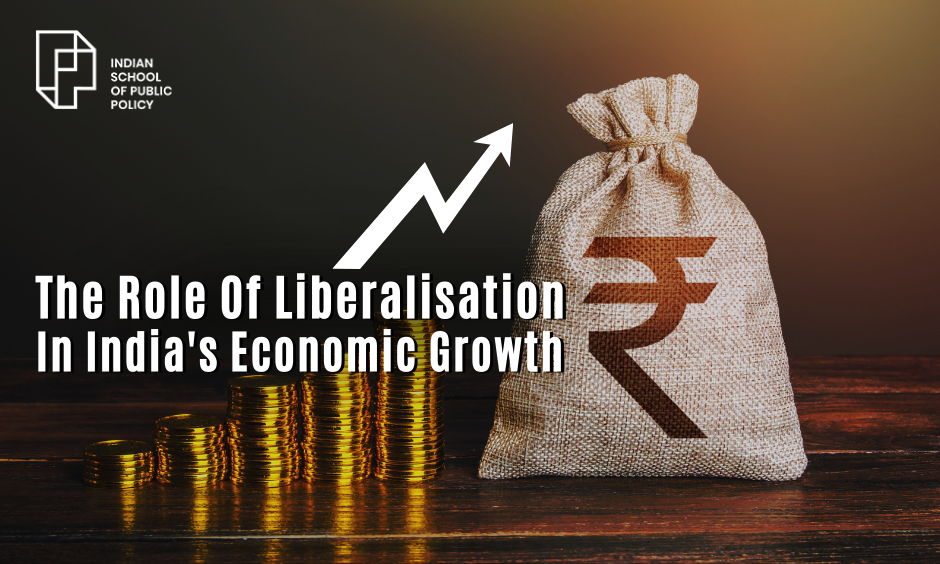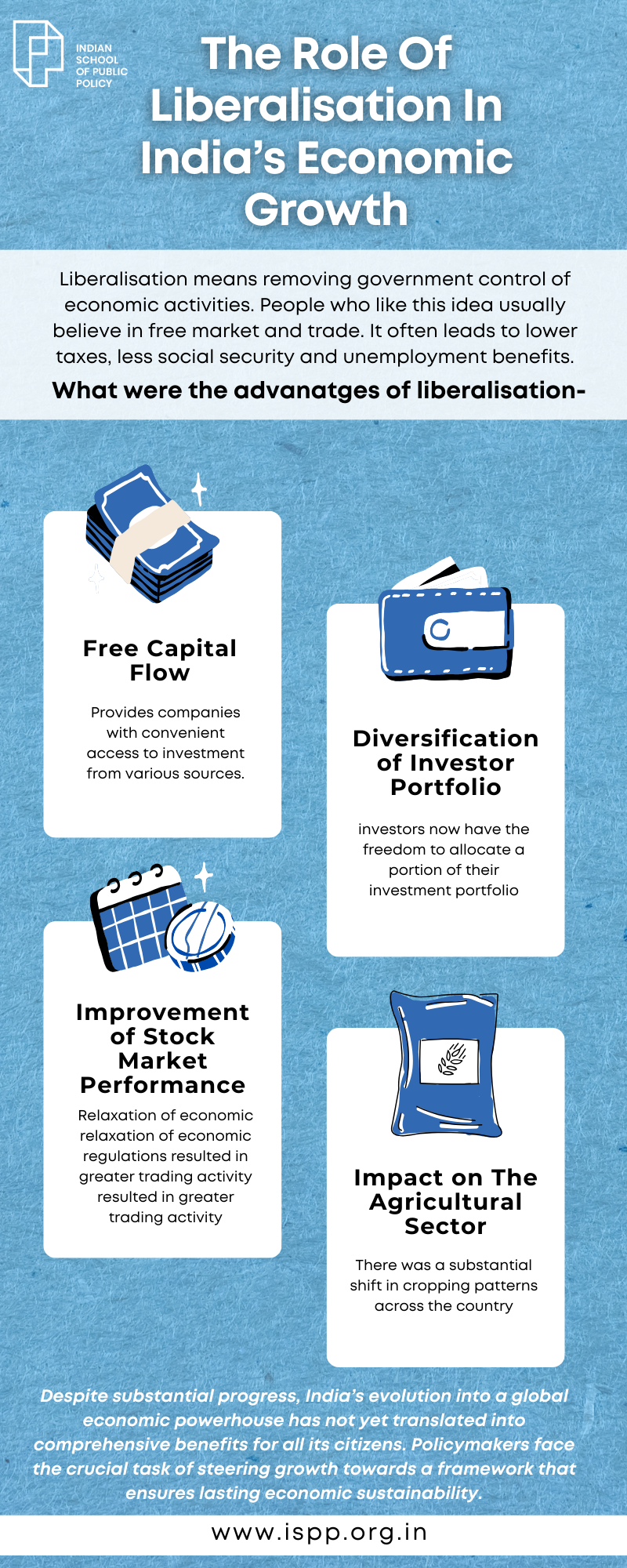
The Role Of Liberalisation In India’s Economic Growth

As the global economy began to grow and international trade gained momentum, it led to increased prosperity and potential for citizens worldwide. In this context, it would have been imprudent for India to remain passive. Thus, we also embarked on the path of economic liberalisation. Despite unsuccessful attempts in 1966 and 1980, the process of liberalisation finally flourished in India in 1991. Liberalisation stands as a crucial aspect of a nation’s development, something every government must prioritise. But what exactly is liberalisation, and more importantly, how does it impact India’s economy?
Read further to gain a deeper understanding.
What Is Economic Liberalisation?
Liberalisation means removing government control of economic activities. People who like this idea usually believe in free market and trade. It often leads to lower taxes, less social security and unemployment benefits. In 1991, India started making changes to it’s economy due to several problems. These changes were really big and changed how the economy worked.
India initiated an economic reform programme with two main sets of measures –
Macroeconomic Stabilisation Measures
These are actions taken to improve the overall demand for the economy, both within the country and from foreign sources. It is crucial to focus on generating high-quality employment opportunities to enhance the public’s purchasing power and consequently stimulate domestic demand.
Structural Reform Measures
This category covers policy adjustments made by the government to boost the overall supply of goods and services in the economy. This often involves removing barriers that restrict the economy’s potential for increased productivity and output.
The objective/ role of liberalisation was to –
- To foster engagement of domestic private enterprises as well as multinational corporations from India.
- To facilitate the global expansion of the Indian economy.
- To enhance foreign trade for bolstering the nation’s exports.
- To address the balance of payments challenge confronted by India.
- To augment the participation of the private sector in India’s economic advancement.
- To elevate foreign direct investment in the Indian industrial landscape.
- To promote healthy competition among domestic enterprises.
Continue reading to learn the new policies that were designed to fulfill these objectives.
What Were These New Policies?
Financial Sector Reforms – The aim of financial sector reforms is to establish a streamlined financial system that enhances the effective allocation of resources, fosters financial inclusion, safeguards trust in the financial system, and ensures its stability.
Tax Reforms – Tax reform involves modifying the methods of tax collection or administration by the government. This is typically done to enhance tax management or to offer economic and social advantages.
Trade and Investment Policy Reforms – Under this reform, the mandate for acquiring licenses was eliminated for all industries except those related to alcohol, cigarettes, hazardous chemicals, industrial explosives, electronics, aerospace, and drugs and pharmaceuticals. The necessity for licenses for establishing new units or expanding existing ones has been removed.
External Sector Reforms – It encompasses a range of policy actions and structural adjustments, designed to enhance the effectiveness, competitiveness, and robustness of the external sector. These include measures like trade liberalisation, management of exchange rates, regulations governing foreign investments, and initiatives for boosting exports.
Deregulation of the Industrial Sector – In the industrial sector, deregulation involves the removal of barriers to entry, reduction of monopolistic practices, and creation of a more competitive and market-driven environment. This process refers to the systematic reduction or elimination of government regulations and controls on businesses and industries.
Foreign Exchange Reforms – Foreign exchange reforms were set in motion in 1991 through the devaluation of the Indian rupee in relation to foreign currencies. As a result, a US dollar or British pound could now fetch a greater number of rupees compared to earlier, signifying that these foreign currencies can procure a greater quantity of goods within the Indian market.
Foreign Trade Policy Reforms – The recently announced Foreign Trade Policy (FTP) of India, initiated by Commerce Minister Shri Piyush Goyal which becomes effective from 1st April , 2023, aims to enhance India’s integration into global value chains and establish the nation as a prominent export hub.
What were the advantages of liberalisation on our country’s economy?
Let’s find out…
Advantages
Free Capital Flow in The Economy – Liberalisation has facilitated the unrestricted flow of capital within our nation, providing companies with convenient access to investment from various sources. Before the era of liberalisation, engaging in profitable projects was often discouraged due to limited capital availability. This situation was rectified in 1991, ushering in a period of increased growth rates.
Diversification of Investor Portfolio – After the process of liberalisation, investors now have the freedom to allocate a portion of their investment portfolio to a diversified range of asset classes, thereby potentially increasing their profits.
Improvement of Stock Market Performance – The relaxation of economic regulations also contributes to an increase in the value of the stock market, thereby fostering greater trading activity among investors.
Impact on The Agricultural Sector – Although accurately measuring the impact of liberalisation on the agricultural sector remains challenging, it is evident that in the period following 1991, there was a substantial shift in cropping patterns across the country.
While liberalisation has undoubtedly ushered in new opportunities, there remains significantly unmet demands for fundamental services like water, sanitation, energy, and healthcare. Despite substantial progress, India’s evolution into a global economic powerhouse has not yet translated into comprehensive benefits for all its citizens. Policymakers face the crucial task of steering growth towards a framework that ensures lasting economic sustainability.
How do policymakers equip themselves to manage growth to ensure sustainable economic performance?
Register your Interest to Study at ISPP
PDM By ISPP
The Post Graduate Programme in Public Policy, Design and Management is the flagship offering of ISPP, designed for individuals aiming to influence the public policy landscape. This one-year course immerses participants in the art of policymaking through a structured curriculum divided into seven terms, each spanning seven weeks. The program culminates with a Capstone Exercise where scholars address modern policy challenges using innovative policy solutions. Beyond academic instruction, the ISPP PDM Programme provides networking avenues, access to professional platforms, and comprehensive career and placement assistance.
Programme Highlights
The program offers a comprehensive grasp of public policy and imparts design and management principles to students, aiming to cultivate enhanced skills in systems thinking and policy leadership. Participants will gain insights not only into policy analysis and formulation but also into the incorporation of pragmatic considerations such as finance, capabilities, and ethics. The curriculum places a strong emphasis on mastering implementation, management, and evaluation best practices, spanning the realms of public administration and policy.
- HARRIS UCHICAGO: CERTIFICATE IN PUBLIC POLICY
- IMMERSIVE LEARNING PROJECTS
- INTERACTIVE LABS
- CAREER SUPPORT & PLACEMENTS
- TEA & POLICY
Click here to learn the class profile 2023.
Academic Pedagogy
ISPP educates its scholars to become leaders in policy action. Our scholars not only partake in a comprehensive academic program in Public Policy but also undergo rigorous training in management, communication, and leadership skills. The one-year academic session is divided into seven terms, each lasting seven weeks.
The academic curriculum at ISPP is meticulously crafted to foster mastery in theory and practice, with the goal of driving change. The curriculum seamlessly incorporates classroom learning, skill enhancement, practical application, and leadership and management training, encompassing foundation, core, and supporting courses.
At ISPP, we embrace a comprehensive approach to policy, design, and management, centered around five fundamental pillars: Skills (S), Political Economy (P), Ethics (E), Leadership (L), and Lifelong Learning (L). Our curriculum and learning environment are designed based on the SPELL framework, ensuring a well-rounded educational experience at our institution.
See what life at ISPP looks like!
Chat With Student Ambassadors


Our student ambassadors consist of our alumni and current students who possess extensive knowledge and experience in public policy. They are available to address any inquiries you might have. Whether you seek more information about our programmes, the admissions process, campus amenities, or student life, our student ambassadors are readily available to provide assistance.
FAQs
What is economic liberalisation, and when did it begin in India?
Economic liberalisation is the process of reducing government controls and regulations on economic activities. In India, it began in earnest in 1991 when the government introduced a series of reforms to open up the economy and encourage private sector participation.
What were the key policy changes introduced during India’s economic liberalisation?
The key policy changes included the deregulation of industries, financial sector reforms, tax reforms, trade liberalisation, and foreign exchange reforms. These measures aimed to make the Indian economy more competitive and market-driven.
How did economic liberalisation impact India’s economic growth?
Economic liberalisation led to higher economic growth rates in India. It attracted foreign investments, increased the ease of doing business, and stimulated various sectors of the economy, contributing to overall growth and development.
Were there any challenges or negative impacts of economic liberalisation in India?
While liberalisation brought many benefits, it also posed challenges such as income inequality and environmental concerns. Some sectors faced increased competition, which required adaptation, and certain regions benefited more than others.
What is the current status of India’s economy after decades of liberalisation?
India’s economy has shown significant growth and transformation since liberalisation. It has become one of the world’s largest economies and continues to attract investments. However, there are still areas where reforms are needed to address ongoing challenges.
Infographic



